What Are the Different Types of Shackles for Lifting and Rigging?
Just like lifting slings and sling hooks, shackles come in a number of different designs and configurations. Careful consideration must be given to the type of shackle body style and pin that is used for your application. In this article, we’ll break down the differences between the shape (bow) of the shackle as well as the different types of pins that are used for load securement.
A shackle is a u-shaped, load-bearing connecting device designed to be used with a removable pin. Shackles can be used in a number of different rigging and load securement applications to connect different types of lifting slings, chain, or rope to an object or to each other.
Shackles can be used in a variety of different applications, including:
- Rigging
- Towing or pulling
- Lifting
- Hoisting
- Tie-down
Just like lifting slings and sling hooks, shackles come in a number of different designs and configurations. It can be confusing to understand the correct type of shackle to use for your application, but you don’t want to guess or choose incorrectly—that could result in a rigging failure that could cause significant damage or injury!
In this article, we’ll break down the differences between the shape (bow) of the shackle as well as the different types of pins that are used for load securement. We’ll also discuss the different types of material that a shackle can be made from and introduce some shackles designed for special applications.
What Are the Different Types of Shackles?
The Parts of a Shackle:
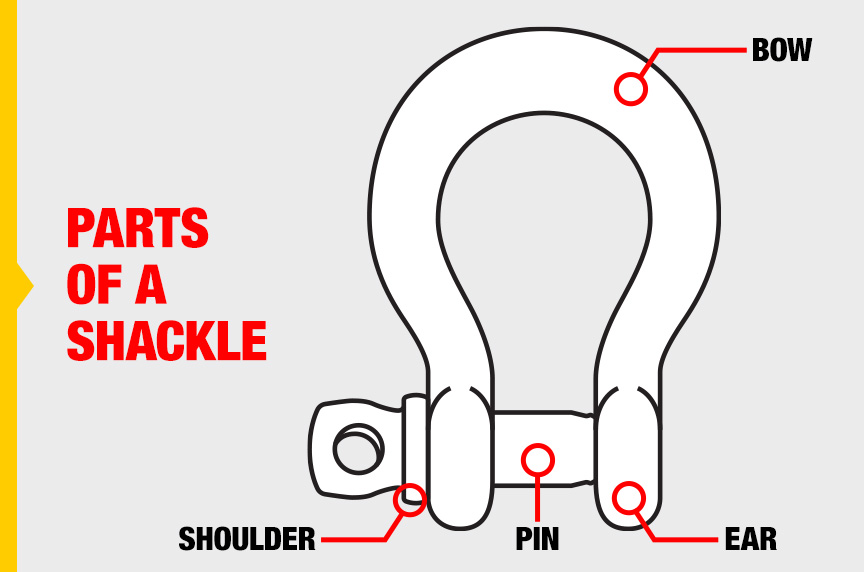
Before we begin, let’s identify the different parts of a shackle so when we use terms like “bow,” “ears,” “pin,” or “shoulder,” you’re familiar with what we’re referring to:
- Bow – the curved portion of the shackle body opposite the pin—often referred to as the bail, body, dee, or bowl
- Ears – portion of the shackle body that support the shackle pin
- Pin – a steel bolt made to span the two shackle ears
- Shoulder – the part of the pin that makes contact against the ear when the pin is fully threaded or engaged
Always ensure that the shackle that you select meets or exceeds the working load limit for the task at hand and is comparable to the Working Load Limit (WLL) of the slings and other rigging hardware being used.
Shackle Bow Types: Anchor Shackles vs. Chain Shackles
The shape of the shackle’s body, or bow, is a major determination in the style of the shackle and how it can be used.
Anchor Shackles / Bow Shackles
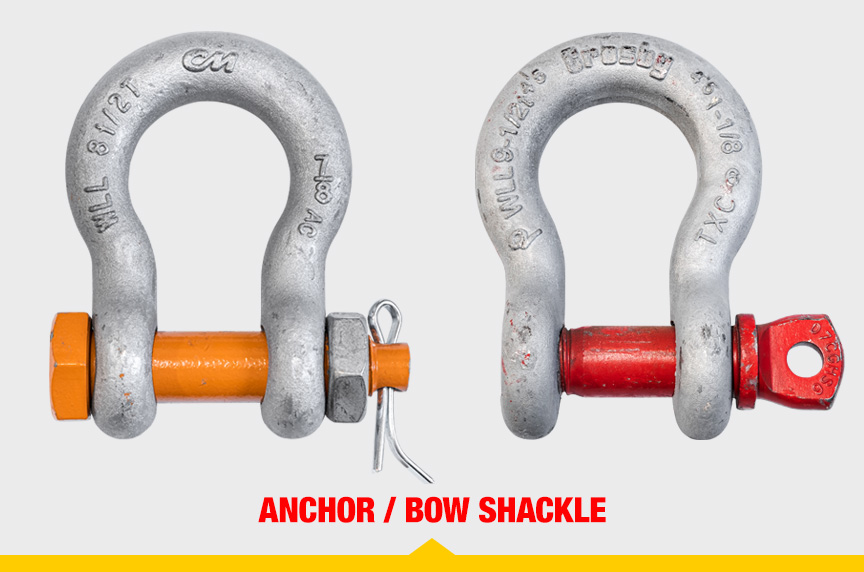
The terms anchor shackles and bow shackles are both used interchangeably and refer to a type of shackle with a larger, round “O” shaped bow. A larger bow shape allows these types of shackles to be side loaded or used in multiple sling-leg connections.
Anchor shackles can be used for side pulling when you factor in the reduction to the WLL based on the angle deviation from in-line (0°)—which we will discuss in more detail later in this article.
Chain Shackles / D Shackles
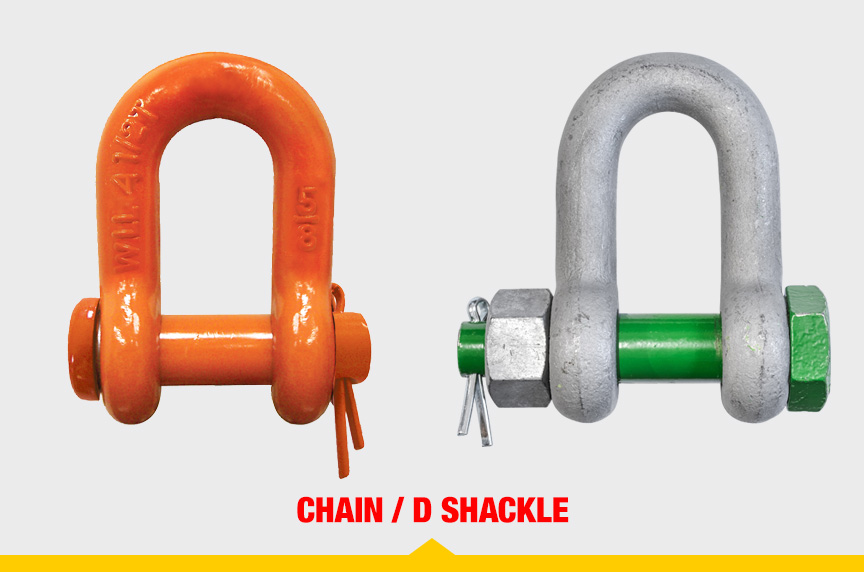
Chain shackles, also referred to as D shackles, have a D-shaped bow that is narrower than anchor shackles. Because these shackles are designed and rated for in-line tension, they should not be side loaded, as side loading can twist or bend the bow of the shackle.
When using a chain shackle, the center line of the load should always coincide with the center line of the shackle when in use.
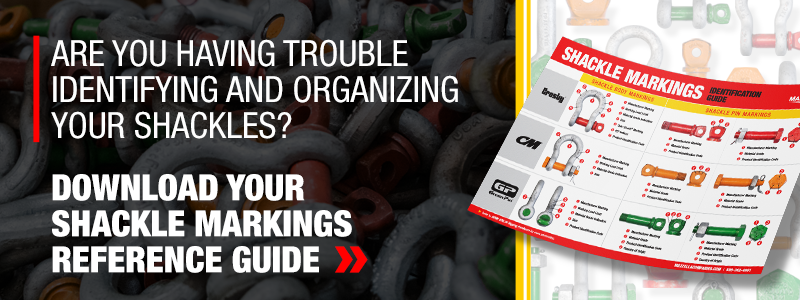
Shackle Pin Types: Screw Pin vs. Bolt Type vs. Round Pin
Careful consideration must be given to the type of shackle pin that is used for your application. Some types of pins are designed to be used for overhead lifting, and other types are not. Some pins are ideal for “pick and lift” scenarios and can be quickly connected and disconnected, while others are more ideal for semi-permanent applications.
Screw Pin Shackles
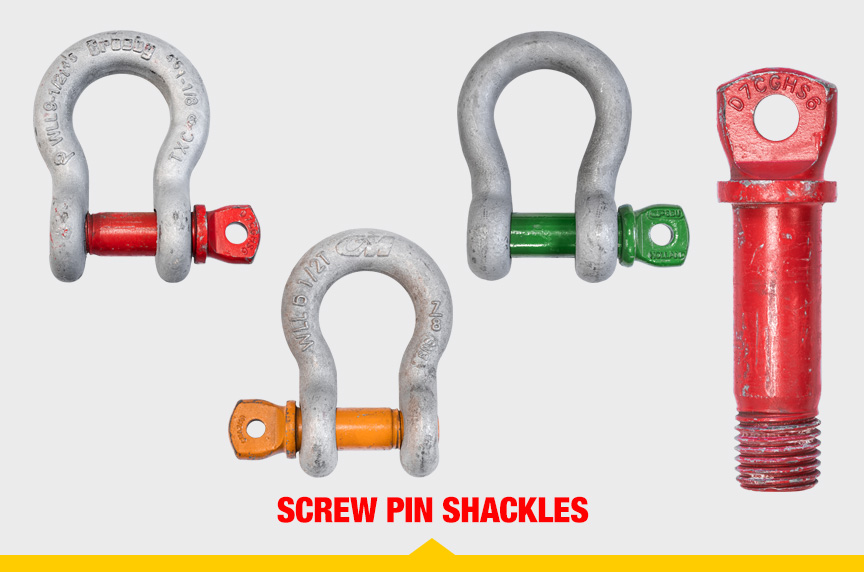
On a screw pin shackle, a threaded pin is inserted through the ears and tightened down. Screw pin shackles are quick and easy to connect and disconnect so they’re convenient for rigging that is used for “pick and place” applications or when slings and other hardware are often changed out. Screw pin shackles are not recommended for permanent or long-term installations.
Screw pin shackles can be used in applications where side loading is present, and with multi-leg sling assemblies. However, reduction to the WLL must be accounted for when used in a side-loading situation.
Be aware that a live line, such as a sling being used in a choker hitch configuration, can cause the screw pin to be rotated, torqued, or twisted which can cause the pin to unthread itself. Always tighten the pin prior to each lift.
To avoid the pin from rotating or loosening due to vibration, mousing can be used as a secondary method of securement. Loop annealed iron wire through the hole in the collar of the pin and around the adjacent leg of the shackle—securely twisting both ends together.
When using a screw pin shackle, the screw pin threads shall be fully engaged, tight, and the shoulder should be in contact with the shackle body.
Bolt Type Shackle
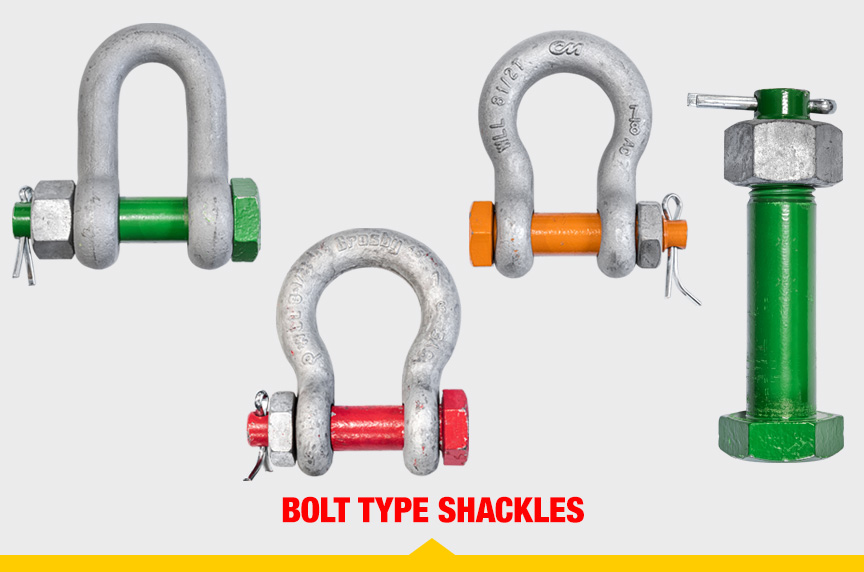
A bolt type shackle is a more secure version used in rigging that features the combination of a bolt and nut located alongside a cotter pin. Bolt type shackles can be used in any application that uses a round pin or a screw pin. These types of shackles remain secure even when the shackle is subjected to rotation or torque.
Bolt type shackles are practical in many rigging applications where the anchor bolt is expected to experience some rotation. The tightening nut and the cotter pin eliminate the need to tighten the pin prior to every lift or movement of a load, so bolt type shackles are excellent choices for semi-permanent or long-term installations, or where the load may slide on the shackle pin causing it to rotate.
Round Pin Shackles
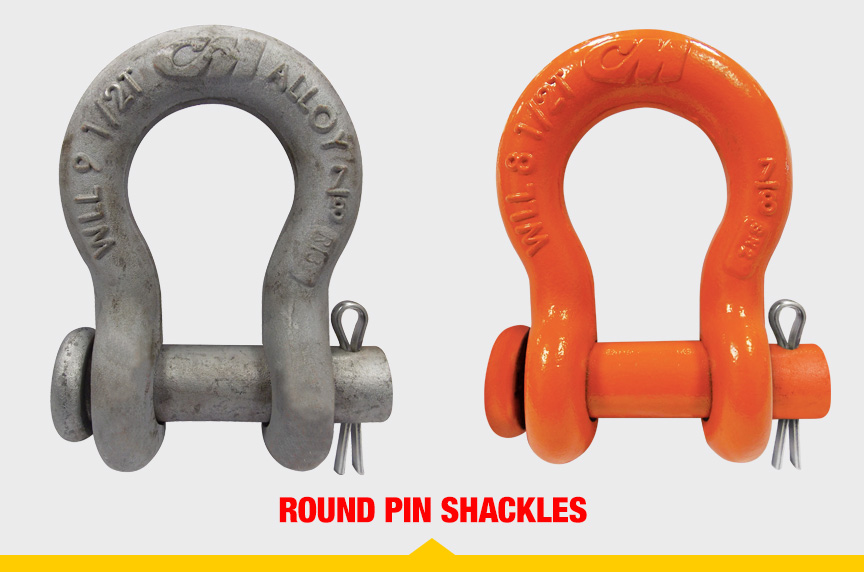
Round pin shackles consist of a round unthreaded pin that is secured in place with a cotter pin. These perform well in applications where the pin may be subjected to torque or twisting.
They’re most popular in tie-down, towing, suspension, or applications where the load is strictly applied in-line. A cotter pin is used to secure the shackle pin in place.
However, round pin shackles are not recommended for overhead lifting applications. Round pin shackles shouldn’t be used as a collector ring in rigging applications where multiple sling legs are present, or where side loading may occur.
Specialty Types of Shackles
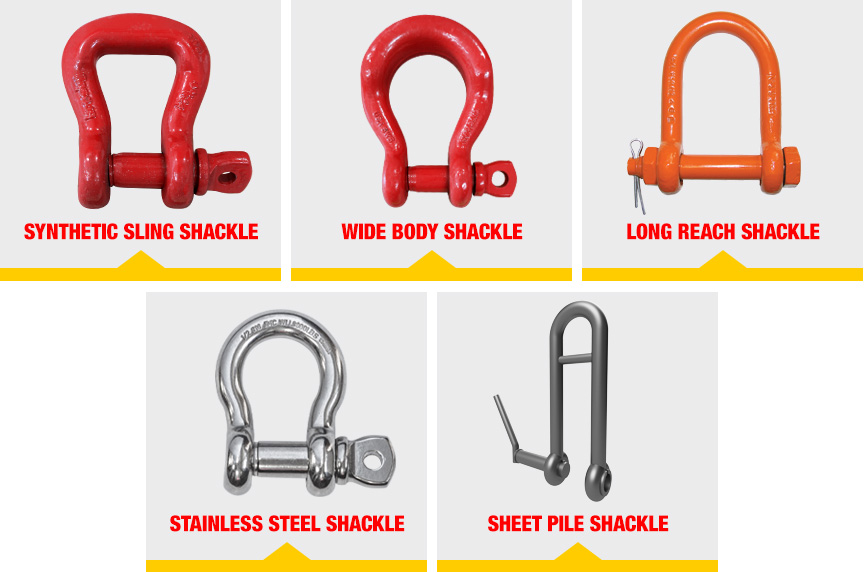
Anchor shackles and chain shackles can be used for a number of different applications and in conjunction with different types of slings, chain, or ropes. However, some applications or rigging configurations require a more specialized shackle:
Synthetic Sling Shackles
On a synthetic sling shackle, the bow of the shackle is widened to increase synthetic web sling or synthetic roundsling efficiency. This design allows for 100% of the sling’s WLL to be achieved by preventing the slings from pinching or bunching, which can damage the slings or reduce their rated capacity.
Synthetic sling shackles are available in screw pin or bolt type design.
Wide Body Shackles
Used in conjunction with high capacity synthetic web slings, synthetic roundsling, or wire rope slings. When using a shackle with wire rope, the shackle must be equal or greater than the wire rope diameter. The increased radius of the shackle bow provides:
- An increase in surface area for a better D/d ratio
- Improved service life of the sling
- Eliminates need for a thimble eye
- Prevents kinking and bunching of the sling around the bow
Long Reach Shackles
These long reach shackles are ideal for use in construction applications where a longer reach is needed to attach to pick points. They can also be used as a bail for lifting thicker products.
Sheet Pile Shackles
Just what their name implies, they’re designed specifically for pulling sheet piling. These types of shackles are equipped with an easy opening pin that will not detach and become lost.
Shackle Material
Carbon Steel Shackles
Design Factor of 6:1. More ductile than alloy. Available in round pin, screw pin, bolt type.
Alloy Steel Shackles
Design Factor of 5:1. Stronger than carbon steel. Can achieve an equivalent WLL as carbon shackles in a smaller product design. Available in round pin, screw pin, bolt type.
Galvanized Shackles
The galvanization process adds a thin layer of zinc oxide to protect against rust and corrosion. Galvanized shackles can be used in industrial applications where moisture isn’t a primary concern, but where the shackles still need to be protected against elements that may cause accelerated corrosion or deterioration to the product.
Stainless Steel Shackles
Stainless steel shackles provide the greatest corrosion resistance and are ideal for marine applications. Varying grades of stainless steel can be used to protect the shackle against salt water or chemical environments. Shackles made from stainless steel are typically more expensive than galvanized shackles.
Considerations When Side Loading Shackles
Some types of shackles are engineered to handle some form of side loading. For these types of shackles, there will be a reduction to the Working Load Limit as specified by the manufacturer.
Chain shackles are not recommended for side loading, as it could permanently twist or deform the bow of the shackle.
Per ASME B30.26 Rigging Hardware, the following rated load reductions will occur when side loading angle deviates from in-line (0°):
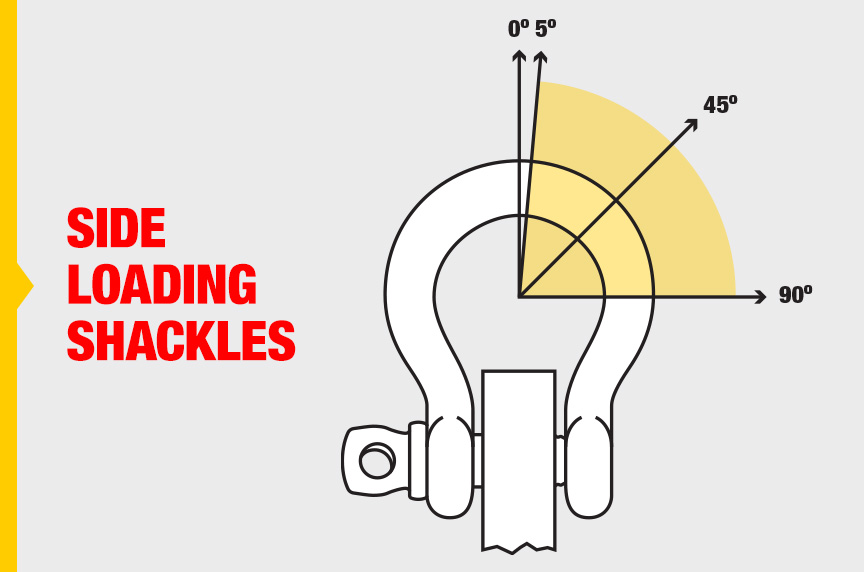
| Side Loading Angle (°) | % of Rated Load Reduction |
|---|---|
| In-line (0° to 5°) | None |
| 6° – 45° | 30% |
| 46° – 90° | 50% |
| Over 90° | Not recommended. Consult with manufacturer or Qualified Person. |
When using a shackle with multiple sling legs, the sling legs should rest against the body of the shackle, not the pin. If multiple sling legs are present in the body, they should not exceed 120° in angle. The angle of loading affects the stress in the shackle, so as the horizontal angle decreases, the stress increases in the shackle—see below:
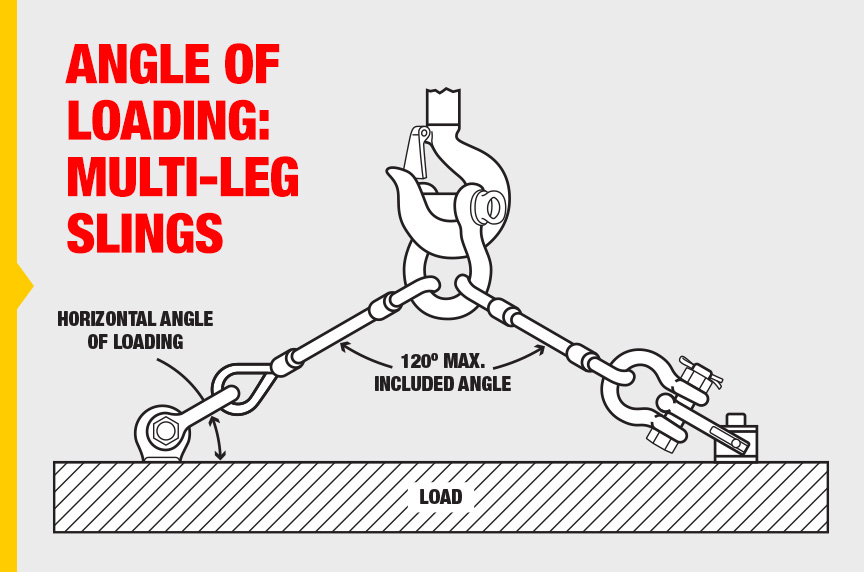
Horizontal Angle (Degrees) | Stress Multiplier |
|---|---|
| 90° | 1.000 |
| 60° | 1.155 |
| 45° | 1.414 |
| 30° | 2.000 |
Wrapping it Up
When it comes down to it, the most important part of determining what type of shackle to use is to have a complete understanding of:
- The total weight of the load
- The type of sling(s) being used
- The type of sling hitch(es) being used
- The angle of the sling(s)
From there, you can partner with a reputable rigging shop, or rigging equipment supplier, to determine the best type of shackles to use for your application. This will ensure that the design of the shackle and its Working Load Limit is adequate for the lifts you’ll be performing.
At Mazzella, we partner with all of the major rigging hardware suppliers in the industry. We can quote and fabricate sling assemblies or get you the individual slings and hardware that you need to put them together yourself.
We offer a full inventory of hooks, shackles, and other rigging hardware from the following manufacturers:
- Crosby
- CM
- Van Beest
- Gunnebo Industries
- Peerless Industrial Group, Inc.
- And more!
We also provide lifting and rigging training and have certified inspectors to fulfill OSHA/ASME periodic inspection requirements. If you want to schedule a consultation, or receive a quote for your next lifting project, contact one of our Lifting Specialists today.
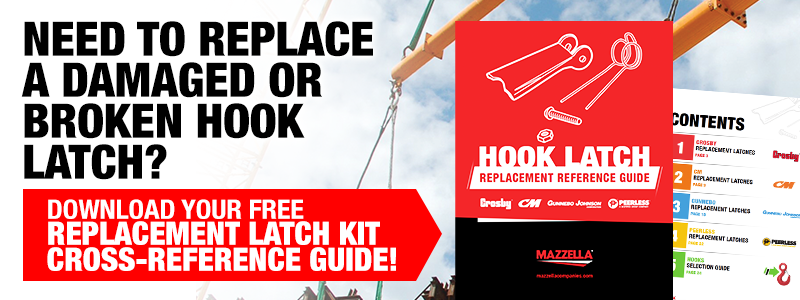

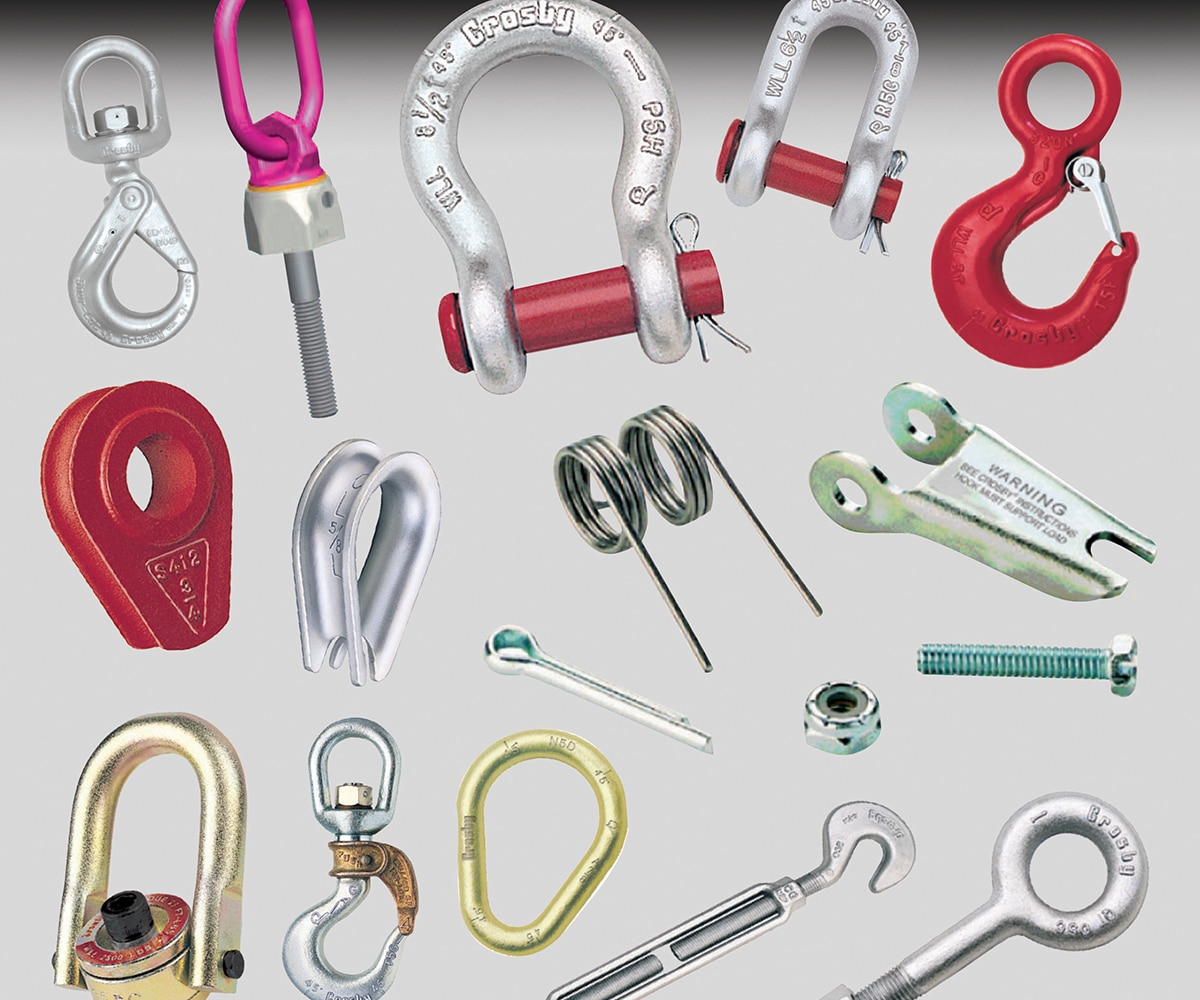
Rigging Hardware
Are you looking for access to a complete inventory of rigging and lifting products from the largest manufacturers in the world?
Contact us if you need shackles, hoist rings, eye bolts, hooks, master rings, links, turnbuckles, and more!
Learn more about lifting and rigging hardware!
Copyright 2019. Mazzella Companies.
